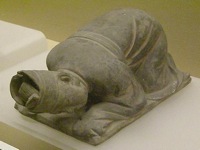Kowtowing
Origin
Chinese (Beijing) kòutóu, from kòu to knock + tóu head
Description
Kowtow, which is borrowed from kòu tóu in Mandarin Chinese, is the act of deep respect shown by kneeling and bowing so low as to have one's head touching the ground. An alternative Chinese term is ketou, however the meaning is somewhat altered: kòu has the general meaning of 'knock', whereas kē has the general meaning of "touch upon (a surface)", tóu meaning head.
In Han Chinese culture, the kowtow is the highest sign of reverence. It was widely used to show reverence for one's elders, superiors, and especially the Emperor, as well as for religious and cultural objects of worship. In modern times, usage of the kowtow has become much reduced.
In Imperial Chinese protocol, the kowtow was performed before the Emperor of China. Depending on the solemnity of the situation different grades of kowtow would be used. In the most solemn of ceremonies, for example at the coronation of a new Emperor, the Emperor's subjects would undertake the ceremony of the "three kneelings and nine kowtows", the so-called grand kowtow, which involves kneeling from a standing position three times, and each time, performing the kowtow three times while kneeling. Immanuel Hsu describes the "full kowtow" as "three kneelings and nine knockings of the head on the ground."
As government officials represented the majesty of the Emperor while carrying out their duties, commoners were also required to kowtow to them in formal situations. For example, a commoner brought before a local magistrate would be required to kneel and kowtow. A commoner is then required to remain kneeling, whereas a person who has earned a degree in the Imperial examinations is permitted a seat.
Since one is required by Confucian philosophy to show great reverence to one's parents and grandparents, children may also be required to kowtow to their elderly ancestors, particularly on special occasions. For example, at a wedding, the marrying couple was traditionally required to kowtow to both sets of parents, as acknowledgement of the debt owed for their nurturing.
Confucius believed there was a natural harmony between the body and mind and therefore, whatever actions were expressed through the body would be transferred over to the mind. Because the body is placed in a low position in the kowtow, the idea is that one will naturally convert to his or her mind a feeling of respect. What one does to oneself has an impact on the mind. Confucian philosophy held that respect was important for a society, making bowing an important ritual.
The kowtow, and other traditional forms of reverence, were much maligned after the May Fourth Movement. Today, only vestiges of the traditional usage of the kowtow remain. In many situations, the standing bow has replaced the kowtow. For example, some, but not all, people would choose to kowtow before the grave of an ancestor, or while making traditional offerings to an ancestor. Direct descendants may also kowtow at the funeral of an ancestor, while others would simply bow. During a wedding, some couples may kowtow to their respective parents, though the standing bow is today more common. In extreme cases, the kowtow can be used to express profound gratitude, apology, or to beg for forgiveness.
The kowtow remains alive as part of a formal induction ceremony in certain traditional trades that involve apprenticeship or discipleship. For example, Chinese martial arts schools often require a student to kowtow to a master. Likewise, traditional performing arts often also require the kowtow.
Kowtow came into English in the early 19th century to describe the bow itself, but its meaning soon shifted to describe any abject submission or grovelling. Many Westerners who first encountered the practice believed it was a sign of worship, but kowtowing does not necessarily have religious overtones in traditional Chinese culture.
The kowtow was a significant issue for diplomats, since it was required to come into the presence of the Emperor of China, but it meant submission before him. The British embassies of George Macartney, 1st Earl Macartney (1793) and William Pitt Amherst, 1st Earl Amherst (1816) were foiled, since kowtowing would mean acknowledging their King as a subject of the Emperor.
Dutch ambassador Isaac Titsingh did not refuse to kowtow during the course of his 1794-1795 mission to the Imperial Court of Emperor Qianlong. The members of the Titsingh mission, including Andreas Everardus van Braam Houckgeest and Chrétien-Louis-Joseph de Guignes, made every effort to conform with the demands of the complex Imperial court etiquette.
The kowtow was often performed in intra-Asian diplomatic relations as well. In 1636, Injo who was king of the Korean Joseon Dynasty had to kneel three times on the ground and touch his head nine times on the ground (三拜九叩頭禮), to show his allegiance to Huang Taiji who was the first Emperor of the Qing Dynasty. This 3*3 kneeling bow continued more than 250 years until 1896 when Korean Empire declared independence as a result of 1st Japan-Sino war. [3]
The King of the Ryukyu Kingdom also had to kneel three times on the ground and touch his head nine times to the ground (三拜九叩頭禮), to show his vassal status to the Chinese Dynasty.
